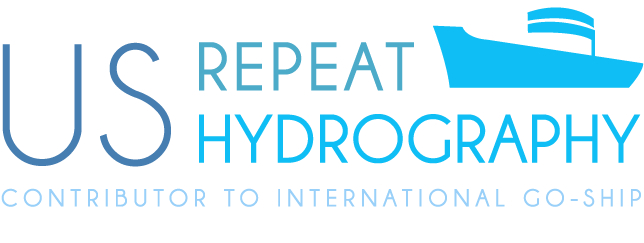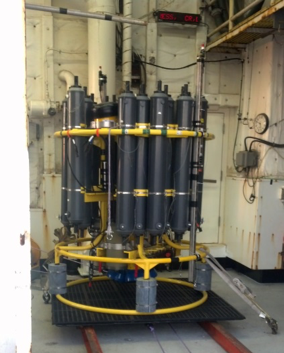
14 November 2016

The first leg of the P18 GO-SHIP project was scheduled to begin Monday Nov. 7th, so I owe an update. However, “Report 0” is being saved for the day we depart from San Diego, CA for the first station on the P18 line at 110°W. Hence “Report -1.” The delay of our start date owes to lingering mechanical issues on the NOAA Vessel Ronald H. Brown (henceforth the “Brown”) that were identified after a dry dock period in San Francisco, CA. A timeline of the repairs and discoveries can be found at the end of this update. Our working departure date estimate is now Thursday Nov. 10th.
The scientific parties are now ready to sail. The 6+ month trail of paperwork leading up to this point concluded on the morning of 11/7 with the last Mexican Visa being issued to a scientist. All permits to conduct research in foreign EEZs have been secured. Most groups have reported successful tests of their equipment. Most equipment is already secured from being sent on a sea trial on 11/7. All scientists are have checked in on the boat at least once. We are not aware of any major unresolved issues.
Staging was complicated but successful, and is now complete aside from tidying up. We simultaneously staged for both legs of the P18 project and the subsequent PNE project. In addition to the full complement of analytical gear, we have 41 floats, ~30 drifters, 5 vans, and ~20 tons of mooring equipment aboard. Accessing the Navy Base pier proved challenging for our personnel and deliveries. However, most problems were anticipated and all were overcome by some combination of extra paperwork, extra money (higher prices for cranes delayed in security), extra effort (notably from the federal employees able to escort scientists on base), and a great deal of help from Brown’s crew. The boat is nearly full with respect to lab and berthing space. Lab space is currently especially tight, but room will be freed up in the coming days as we move empty boxes into empty shipping vans. The space vacated by drifter deployments will be filled in with filled sample containers that need to be kept temperature controlled. We anticipate the heavy load-out will ultimately save considerable taxpayer money and scientist time that would otherwise have been spent shipping to remote foreign ports.
Stay tuned for report 0 for an overview of the scientific programs aboard.
Captain Kamphaus and his crew have been communicative, responsive, supportive, and welcoming throughout the process of planning, staging, and dealing with the Brown’s mechanical issues. We have relied heavily on his team for navigating Navy Base security measures and getting equipment aboard and stowed.
In short, the science complement seems ready and eager to depart from port. Hopefully the mechanical issues will be addressed on schedule soon, and I can start sending you cruise reports with positive integers.


10/04/2016 Scheduled completion of dry dock repair period is delayed from 10/16/2016 to 10/20/2016:
Two significant items were discovered during the drydocking which caused the delays: (1) the #2 main propulsion diesel generator (MPDG) had mechanical damage where the rotor had touched the windings = rewinding the generator which took 30 days and (2) the thrust collars where the z-drives insert into the ship were worn and out of round. These required machining of the hull and fabrication of the new collars.
10/07/2016 Leg 1 of the P18 GO-SHIP project is delayed by 5 days in light of the shifting schedule. Leg 2 is delayed by 4 days.
10/20/2016 Brown completes the dry dock repair period. Many repairs were completed. Notable repairs for GO-SHIP work include:
1. Overhaul of both Markey winches.
2. Replacement of the aft winch wire with new 0.322” wire. Forward wire is “gently used.”
10/22/2016 Brown completes sea trials (1 of 3) in the San Francisco Bay. This trial is considered a success.
10/24/2016 A previously unsolved intermittent issue with the GE propulsion motor drive cabinets (automation that runs the propulsion motors) re-surfaces on the transit from San Francisco to San Diego.
10/26/2016 A second sea trial (2 of 3) is conducted with the goal of resolving the drive cabinet issue that resurfaced on the transit, but work done on the sea trial does not identify the cause.
~10/27/2016 An issue is communicated regarding the aft winch’s ability to spool.
~10/28/2016 A Markey representative identifies a wiring error on the aft winch. Fixing it resolves the winch issue.
11/01/2016 A third (3 of 3) sea trial is scheduled for Monday 11/07 with representatives from the company that creates the drive cabinets on board.
11/04/2016 Overtightened screws on an engine part (the aluminum rocker arm baseplate) are reported to have caused damage. This damage was first apparent at the end of the second sea trial and manifested with oil leaking onto the engine. The report comes near the end of the business day, so no parts are scheduled to be ordered on 11/07. That evening the cruise is delayed to 11/09 or 11/10 on a TBD basis.
11/07/2016 Sea trials (3 of 3) are conducted and the drive cabinet issue is identified, a fix is made, and the issue is declared resolved. Replacement parts are ordered for the damaged engine part (first business day since discovery). The expected sailing date is pushed to 11/10 at 1000.